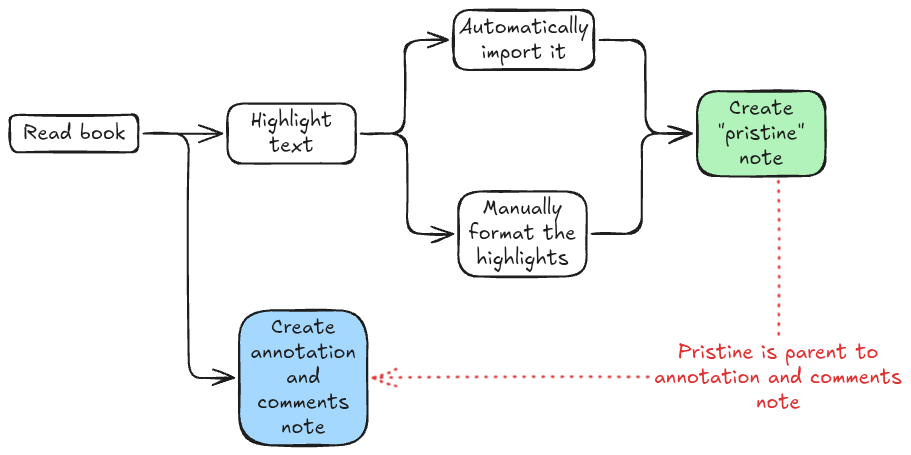Taking Notes About Books
One of the most common types of notes I have, after my journal notes, are notes about books I've read.
As an avid reader (100+ books per year), I had to learn how to take notes or I wouldn’t remember much. For a long time, I didn’t have a process — I read 200–300 books after graduation without taking any notes.
Here’s my current process.
Reading
- Most of my reading is digital.
- Benefits: easier to carry, easier to extract information.
- Workflow:
- Skim the book first.
- Reset progress to “not read” before starting (to avoid skewed progress tracking).
Process Skeleton
I usually create two notes per book:
-
Pristine note (highlights)
- Automatically generated from Kindle highlights (or exported manually).
- Contains only data from the book, no personal comments.
- Serves as the parent note.
-
Annotations note (comments & thoughts)
- Manually created.
- Contains my reflections, questions, and learnings.
- Links back to the pristine note.
- Derived notes (children, friends, opposing notes) branch out from here.

Creating Each Note
- Pristine note:
- Generated automatically (Kindle Highlights Plugin or Book Search Plugin).
- If manual, I use book template.
- I don’t edit this note manually — if needed, I regenerate it.
- Annotations note:
- Created manually with Template - Generic.
- Contains metadata + free-form commentary.
- If no highlights exist, I still generate a pristine note (for consistency and automation).

Processing by Book Type
1. Amusement Books
- Examples: fiction, drama, detective stories, magazines.
- Usually no notes.
- Occasionally a highlight if a phrase stands out.
2. Philosophy, Parenthood, Self-Help
- Always have highlights.
- Sometimes annotations (e.g., linking parenthood insights to my kids’ situations).
- Philosophy books often become hubs for personal improvement.
3. Technical and Management Books
- Always have both highlights and annotations.
- Notes often become parents/friends of derived notes.
- Practical learnings applied to daily life.
Plugins
- Kindle Highlights Plugin — main source of pristine notes.
- Book Search Plugin — for books not read on Kindle.
- Other plugins: process exported HTML from sideloaded or non-Kindle books.
Using the Data — Visualization
- Books sorted by:
- Number of highlights (descending).
- Last updated date (descending).
- Assumption: more highlights = more influence (not always true, but a useful heuristic).
- Visualization: DV_Livros — card view of my library.
- Rarely used, but nice for overview or sharing.
Key Takeaways
- Two-note system: pristine (data) + annotations (thoughts).
- Automation ensures consistency and reduces manual work.
- Different book types → different levels of processing.
- Visualization adds perspective, even if rarely used.